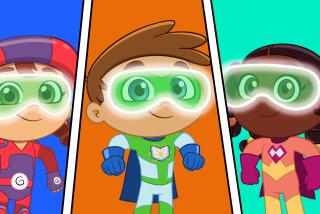PBS Tells Young Viewers: It’s Time to Learn : Television: A block of children’s programs will be offered weekdays for up to 10 hours on 11 stations, including KCET.
Ready, set . . . “Ready to Learn. “
With much fanfare, including announcements packaged in a clear plastic replica of a child’s briefcase, PBS this week launched its much-ballyhooed “Ready to Learn Service” for children 2-12.
But at first blush, it appears that it’s mainly the labeling and packaging that have changed.
As part of the “Ready to Learn” package, up to 10 hours of children’s programming will be offered weekdays on 11 public TV stations in 10 markets--including Los Angeles’ KCET-TV Channel 28--roughly 25% of U.S. households. Previously, PBS had offered about seven hours a day of children’s programming.
All of it is familiar stuff--including Mr. Rogers, Barney, Lamb Chop, “Reading Rainbow” and, of course, “Sesame Street.” Even the so-called new show in the summer lineup--KCET’s “Storytime”--has been running nationally since June 6 (and locally since October, 1992).
Alice Cahn, PBS’ director of children’s programming, isn’t bothered by the lack of fresh programming. “Kids want to watch their favorite things over and over again,” she notes, “and a sense of consistency is very important to us. I don’t feel a real need to premiere brand-new stuff.”
In fact, “Ready to Learn” contains repeats within each day’s schedule. On the nine-hour feed, 2 1/2 hours duplicate each other. On a 10-hour feed, there are 3 1/2 hours of duplication.
“No one who cares about their children would want them spending that much time in front of a television set,” Cahn explains. “(We’re) providing a safe haven for parents and kids (to find) programming that’s entertaining, educational, engaging, motivational. . . . We’re kind of like a supermarket. You don’t buy everything you see on the shelves but it’s good to know it’s all available.”
At KCET, the children’s program schedule has a morning block airing from 6 a.m. to noon and afternoon programming from 4 to 5:30 p.m. On July 25, the station will add a second half-hour of “Storytime” at noon and a second half-hour of “Reading Rainbow” at 12:30--bringing the total to 8 1/2 hours a day of children’s programming.
A station spokeswoman said KCET was delaying the additional hour to complete college telecourses.
KCET, meanwhile, is playing a key role in new children’s program production. “Storytime,” a $3.6-million production, is designed to get preschoolers to read by having such actors as Tom Selleck, A Martinez and Cloris Leachman read stories to children. “The Puzzleworks,” which KCET is co-producing with Lancit Media Productions Ltd. of New York (“Reading Rainbow”), will air in January. “Puzzleworks,” featuring a cast of multicultural “people puppets,” is designed, says PBS, to “help preschoolers and their care-givers understand the values of diversity and individuality.” It has received $8 million in funding.
Two new programs will join the “Ready to Learn” package in the fall:
* On Sept. 11, “The Magic School Bus” arrives. The animated series is based on the popular children’s book series. Lily Tomlin is the voice of Mrs. Frizzle, a teacher who stimulates students’ passion for science by taking them on unusual field trips with the help of a magic bus.
* On Oct. 10, “Bill Nye the Science Guy” comes on board. A co-production of KCTS Seattle and Disney’s Buena Vista Television, it has been airing in syndication on commercial stations.
While a dozen or more children’s programs are now in the production pipeline, Cahn estimates three to five more programs will be added to “Ready to Learn” in the next few years.
As “glue” between programs, “Ready to Learn” will intersperse a series of fast-paced 15- to 60-second segments on such topics as information gathering, task completion and negotiation skills.
In January, 37 additional stations will begin the “Ready to Learn” service, covering half the country. The service will be available to all PBS outlets in 1996.
More to Read
The complete guide to home viewing
Get Screen Gab for everything about the TV shows and streaming movies everyone’s talking about.
You may occasionally receive promotional content from the Los Angeles Times.






